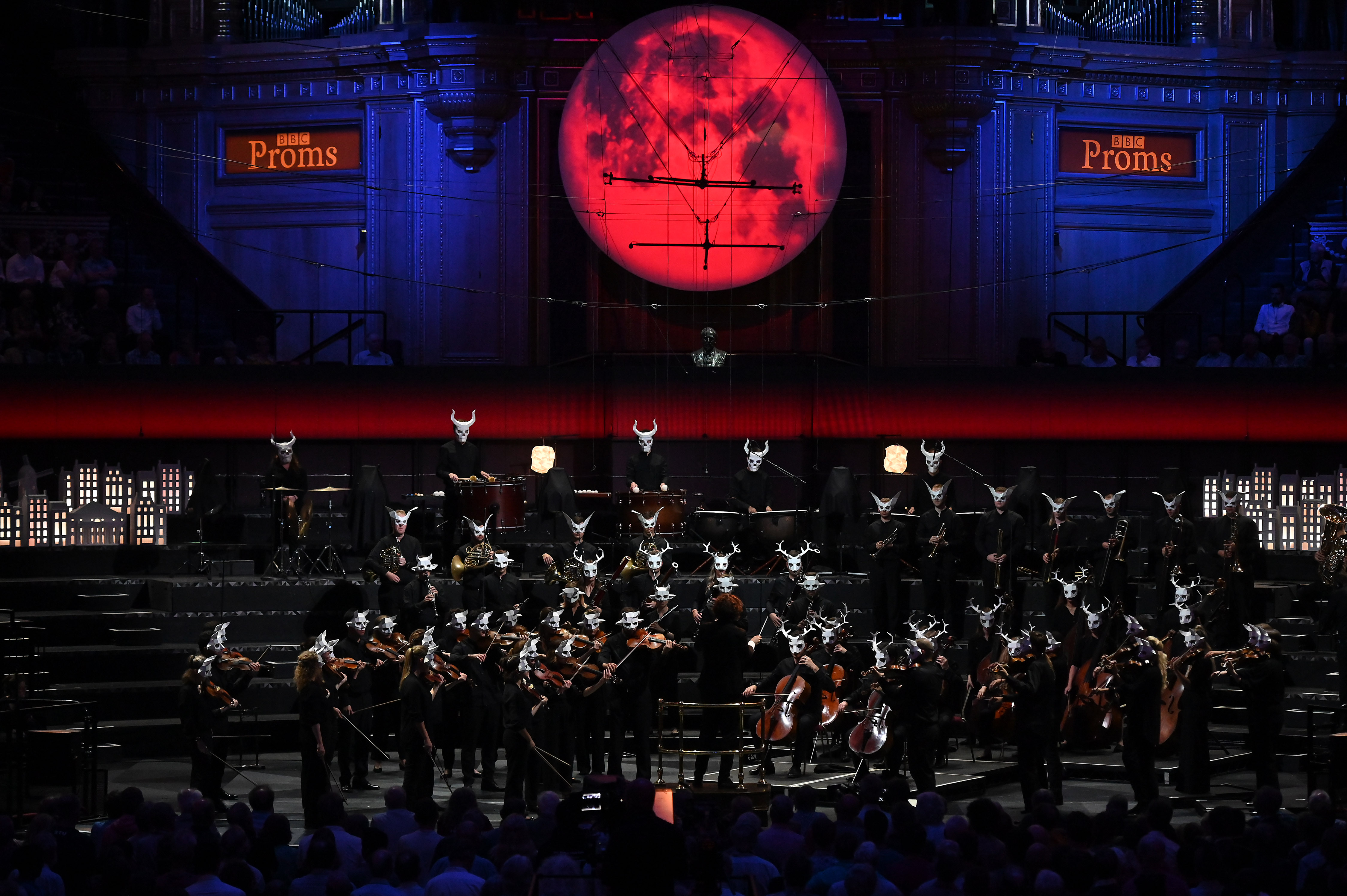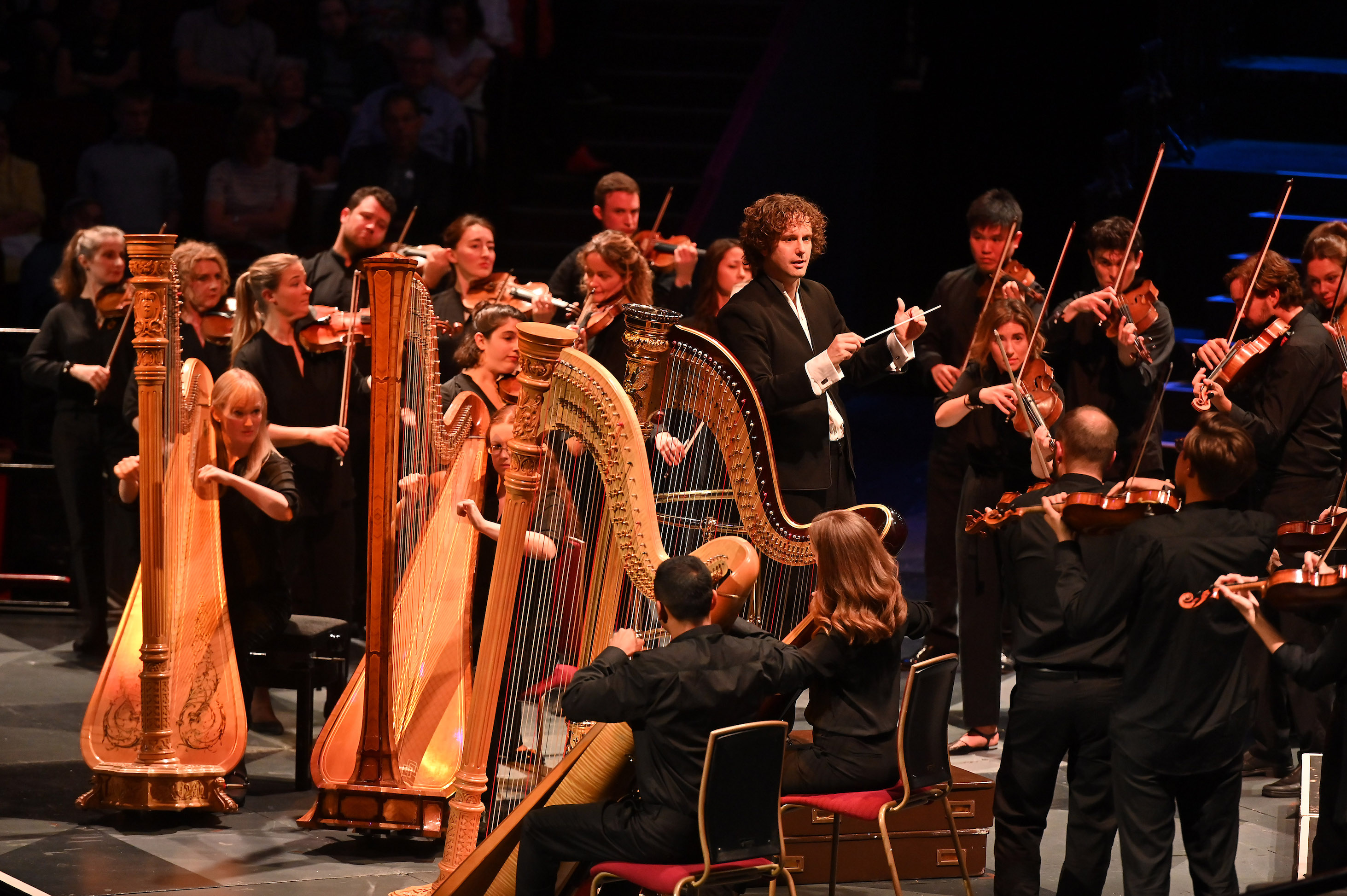Prom 72/3: Aurora Orchestra, Collon review – Berlioz not quite lost in showbiz | reviews, news & interviews
Prom 72/3: Aurora Orchestra, Collon review – Berlioz not quite lost in showbiz
Prom 72/3: Aurora Orchestra, Collon review – Berlioz not quite lost in showbiz
Stagey stunts but fine music in dramatised 'Symphonie fantastique'
For a few seconds last night, the Royal Albert Hall turned into London’s biggest – and cheesiest – disco.
For more than a decade, the enterprising Auroras have not only revitalised a stable of repretoire warhorses through their thrillingly alert, fully memorised performances. They have found fresh ways to make the familiar masterworks live in new ways for new audiences. Not every gambit they try will come off, of course. Last night saw a few missteps and longueurs. Crucially, though, the musical bedrock for their adventures never cracks. Both as an ensemble and in its solo voices, the Aurora – its forces swollen last night by guests who included the ace timpanist Antoine Siguré– sounded a stylish outfit even if you closed your eyes.
More problematic was the shift from the format of the music-education lecture with which Collon began – along with some so-so badinage with actor Mathew Baynton, who spoke Berlioz’s words and embodied his suffering artist – to the dramatised symphony itself. This prosy preamble could have been shorter, although Collon’s demonstration of how Berlioz evolves his ideé fixe love theme – as groups of instrumentalists entered to play the relevant passages – lucidly made its points. Having sold us the wonders of this “novel and magnificent” story-telling symphony that opened the road not just to Wagner’s operas but the Star Wars scores as well, Collon and Baynton didn't then lapse into silence and let the music do the rest of the talking. Each of the five movements had its own spoken introduction by Baynton too: superfluous, perhaps, though it’s always a pleasure to hear the tangy prose of Berlioz’s Memoirs.

Collon spun them through wide dynamic arcs of sound, making the most of some hall-shaking crescendos. He was never afraid either to put the brakes on tempi whose variations underlined every changing passion of the score. Watching over this frenetic action, an outsize French tricolore gave way in the country scene and afterwards to a vast projected moon, which turned a lurid blood-red for the witches’ sabbath of the finale.

Good fun, yes, but the music should scare us enough – as it did – to make fancy-dress costumes from some Hammer Horror-themed party irrelevant. So by no means every histrionic flourish worked. Collon and his creative team still deserve plaudits for the ingenious showbiz swagger they brought to this most stage-struck of symphonies. Above all, the music-making never lost its way even as the players traipsed around the hall. Berlioz, that supreme old ham, would have relished their commitment above all.
rating
Share this article
The future of Arts Journalism
You can stop theartsdesk.com closing!
We urgently need financing to survive. Our fundraising drive has thus far raised £33,000 but we need to reach £100,000 or we will be forced to close. Please contribute here: https://gofund.me/c3f6033d
And if you can forward this information to anyone who might assist, we’d be grateful.

Subscribe to theartsdesk.com
Thank you for continuing to read our work on theartsdesk.com. For unlimited access to every article in its entirety, including our archive of more than 15,000 pieces, we're asking for £5 per month or £40 per year. We feel it's a very good deal, and hope you do too.
To take a subscription now simply click here.
And if you're looking for that extra gift for a friend or family member, why not treat them to a theartsdesk.com gift subscription?
more Classical music
 Marwood, Crabb, Wigmore Hall review - tangos, laments and an ascending lark
Accordion virtuoso’s brilliant arrangements showcase the possibilities of the instrument
Marwood, Crabb, Wigmore Hall review - tangos, laments and an ascending lark
Accordion virtuoso’s brilliant arrangements showcase the possibilities of the instrument
 Batiashvili, LSO, Pappano, Barbican review - French and Polish narcotics
Szymanowski’s fantasy more vague than Berlioz’s, but both light up the hall
Batiashvili, LSO, Pappano, Barbican review - French and Polish narcotics
Szymanowski’s fantasy more vague than Berlioz’s, but both light up the hall
 Owen, Manchester Camerata, Takács-Nagy, Stoller Hall, Manchester review - more Mozart made in Manchester
Another breath of fresh air in the chamber orchestra’s approach to the classics
Owen, Manchester Camerata, Takács-Nagy, Stoller Hall, Manchester review - more Mozart made in Manchester
Another breath of fresh air in the chamber orchestra’s approach to the classics
 Josefowicz, LSO, Mälkki, Barbican review - two old favourites and one new one
Julia Perry well worth her place alongside Stravinsky and Bartók
Josefowicz, LSO, Mälkki, Barbican review - two old favourites and one new one
Julia Perry well worth her place alongside Stravinsky and Bartók
 Classical CDs: Jelly Babies, porridge and kazoos
German art songs, French piano concertos and entertaining contemporary music
Classical CDs: Jelly Babies, porridge and kazoos
German art songs, French piano concertos and entertaining contemporary music
 Jean-Efflam Bavouzet, Wigmore Hall review - too big a splash in complete Ravel
Panache but little inner serenity in a risky three-part marathon
Jean-Efflam Bavouzet, Wigmore Hall review - too big a splash in complete Ravel
Panache but little inner serenity in a risky three-part marathon
 Karim Said, Leighton House review - adventures from Byrd to Schoenberg
The Jordanian pianist presents a magic carpet of dizzyingly contrasting styles
Karim Said, Leighton House review - adventures from Byrd to Schoenberg
The Jordanian pianist presents a magic carpet of dizzyingly contrasting styles
 Stile Antico, Wigmore Hall review - a glorious birthday celebration
Early music group passes a milestone still at the top of its game
Stile Antico, Wigmore Hall review - a glorious birthday celebration
Early music group passes a milestone still at the top of its game
 Hallé, Elder, Bridgewater Hall, Manchester review - premiere of new Huw Watkins work
Craftsmanship and appeal in this 'Concerto for Orchestra' - and game-playing with genre
Hallé, Elder, Bridgewater Hall, Manchester review - premiere of new Huw Watkins work
Craftsmanship and appeal in this 'Concerto for Orchestra' - and game-playing with genre
 First Person: young cellist Zlatomir Fung on operatic fantasies old and new
Fresh takes on Janáček's 'Jenůfa' and Bizet's 'Carmen' are on the menu
First Person: young cellist Zlatomir Fung on operatic fantasies old and new
Fresh takes on Janáček's 'Jenůfa' and Bizet's 'Carmen' are on the menu
 Classical CDs: Chinese poetry, rollercoasters and old bookshops
Swiss contemporary music, plus two cello albums and a versatile clarinettist remembered
Classical CDs: Chinese poetry, rollercoasters and old bookshops
Swiss contemporary music, plus two cello albums and a versatile clarinettist remembered

Add comment